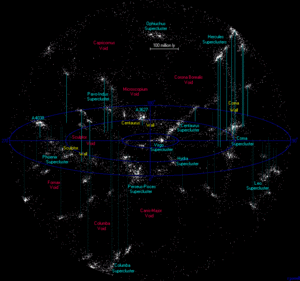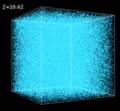Void (astronomy) facts for kids
In astronomy, voids are like giant empty bubbles in space. They are the huge spaces found between filaments, which are long, thin strands of galaxies. Both voids and filaments are some of the biggest structures in the Universe. Voids have very few or no galaxies inside them. Most voids are about 11 to 150 million parsecs (Mpc) wide. A parsec is a unit of distance used in astronomy, and a million parsecs is a very, very long way!
Some voids are extra large and don't have many superclusters (which are huge groups of galaxies). These extra-large empty spaces are sometimes called supervoids.
Contents
What Are Cosmic Voids?
Cosmic voids are vast, empty regions of space. Imagine the universe as a giant sponge. The sponge itself, with its holes and connections, is like the cosmic web. The holes are the voids, and the sponge material is where galaxies and galaxy clusters are found. These voids make up a large part of the universe's volume.
How Voids Form
Scientists believe voids formed from tiny differences in the early universe. After the Big Bang, matter was spread almost evenly. But there were tiny spots where matter was a little bit denser and other spots where it was a little less dense. Over billions of years, gravity pulled matter from the less dense areas into the denser areas. This caused the dense areas to grow into filaments and galaxy clusters, while the less dense areas became even emptier, forming voids.
Size and Features of Voids
Voids can be different sizes. The smallest ones are about 11 Mpc across, while the largest, called supervoids, can be over 150 Mpc wide. To give you an idea, our own Milky Way Galaxy is part of a local group of galaxies, and that group is part of a larger structure. Voids are much, much bigger than individual galaxies or even galaxy clusters. They are mostly empty, but sometimes you might find a few small galaxies inside them.
Famous Supervoids
In 1994, scientists officially counted many supervoids. Here are a few examples of these incredibly large empty spaces in the universe:
| # | Name | Distance (Mpc) | Diameter (Mpc) |
|---|---|---|---|
| 1 | 188 | 124 | |
| 5 | 182 | 130 | |
| 9 | Southern Local Supervoid | 135 | 158 |
| 18 | 168 | 144 | |
| 19 | 168 | 152 | |
| 20 | Bootes Void | 304 | 110 |
| 21 | 201 | 163 | |
| 24 | Northern Local Supervoid | 86 | 146 |
The Bootes Void is one of the most famous supervoids. It's so big that it was once called the "Great Nothing." It's about 304 Mpc away from us and is around 110 Mpc wide. Imagine how much empty space that is!
Studying Voids
Scientists study voids to understand how the universe grew and changed over time. By looking at the size and distribution of voids, they can learn more about dark matter and dark energy, which are mysterious parts of our universe that we can't see directly but know are there because of their effects on gravity and the expansion of the universe. Voids are like giant cosmic laboratories that help us test our ideas about the universe.
Images for kids
See also
 In Spanish: Vacío (astronomía) para niños
In Spanish: Vacío (astronomía) para niños






